![]()
![]()
![]()
Use LEFT and RIGHT arrow keys to navigate between flashcards;
Use UP and DOWN arrow keys to flip the card;
H to show hint;
A reads text to speech;
57 Cards in this Set
- Front
- Back
|
Root development |
Prefunctional phase |
|
|
Tooth eruption and maintenance of occlusion |
Functional phase |
|
|
Stages of crown development |
Initiation/ Dental lamina stage (induction) Bud stage (proliferation) Cap stage (proliferation) Bell stage (differentiation) Apposition( induction) Maturation(maturation) |
|
|
Initiation until completion of the crown formation |
Pre-eruptive phase |
|
|
Appears as a thickening of the oral epithelium adjacent to condensation of ectomesenchyme |
Dental lamina |
|
|
Dental lamina begins to function at _________ and continues to __________ year of birth |
6th prenatal week 15th year of birth |
|
|
Lamina from which permanent teeth develops |
Successional lamina |
|
|
At the leading edge of the lamina _________________ of enlargement appear, which form _________ for the 20 primary teeth |
20 areas Tooth buds |
|
|
Tooth bud forms a cup shape with deep cervical depression |
Enamel organ/ dental organ |
|
|
Condensed mass of mesenchyme within the concavity of the enamel organ |
Dental papilla |
|
|
Condensed mass of mesenchyme surrounding the enamel organ |
Dental sac |
|
|
Enamel organ future dental tissue produced |
Enamel |
|
|
Dental papilla future dental tissue produced |
Dentin pulp |
|
|
Dental sac future dental tissue produced |
Cementum, periodontal ligament and alveolar bone |
|
|
Increasing amount of collagen fibers forming around the enamel organ |
Dental sac |
|
|
Outer cuboidal cells of the enamel organ |
OEE ODE |
|
|
More outer star shaped cells in many layers forming a network within the enamel organ |
Stellate reticulum |
|
|
More inner component layer of that to cuboidal cells |
Stratum intermedium |
|
|
Innermost tall columnar cells of the enamel organ |
IEE IDE |
|
|
Outer layer of cells of the dental papilla nearest the inner enamel epithelium of the enamel organ. A basement membrane known as the membrane preformative exist between these layers |
Outer cells of the dental papilla |
|
|
Inner cell mass of the dental papilla |
Inner cells of the dental papilla |
|
|
Will differentiate into cementum, periodontal ligament and alveolar bone |
Dental sac |
|
|
Serves as protective barrier for the enamel organ |
OEE ODE |
|
|
Supports the production of the enamel matrix |
Stellate reticulum and Stratum intermedium |
|
|
Will differentiate into ameloblasts that will form the enamel matrix |
IEE IDE |
|
|
Will differentiate into odontoblast that will form the dentin matrix |
Outer cells of the dental papilla |
|
|
Will differentiate into the pulp |
Inner cells of the dental papilla |
|
|
After _______ , _________ secretes an acellular dental cuticle known as the ______________ or the _________ to cover the newly formed enamel. |
Enamel apposition Ameloblast Primary enamel cuticle Nasmyth's membrane |
|
|
The enamel organ cells undergo compression to become the ____________. |
Reduced enamel epithelium (REE)/ Reduced dental epithelium (RDE) |
|
|
___________ takes place after the crown is completely shaped and the tooth is starting to erupt into the oral cavity |
Root development |
|
|
Structure responsible for root development |
Cervical loop |
|
|
Bilayer rim that consist of only OEE & IEE |
cervical loop |
|
|
Cervical loop encloses more of the dental papilla and forms |
HERS |
|
|
Lacks the intermedium layers of the stellate reticulum and stratum intermedium so that it fails to differentiate in ameloblast |
HERS |
|
|
Functiin to shape the roots and induce destinogenesis in the root area so that it is continuous with coronal dentin |
HERS |
|
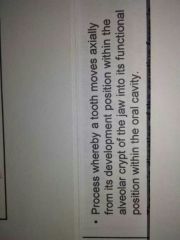
|
Tooth eruption |
|
|
Main direction of the eruptive force is ______ however movements also occur in other planes acxounting to _____and ______. |
Axial Tilting and drifting |
|
|
______ are greatest at the time of crown emergence |
Eruption rates |
|
|
The rate of eruption represents a balance between ______ and _____. |
Eruptive force Resistive force |
|
|
Being offered by the overlying soft tissue and alveolar bone, viscosity of the surrounding periodontal ligaments (dental follicle) and occlusal forces |
Resistive force |
|
|
Property of the periodontal ligament or the dental follicle (sac) |
Eruptive mechanism |
|
|
Doea not require a tractional force pulling the tooth towards the mouth |
Eruptive mechanism |
|
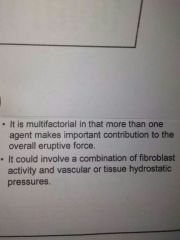
|
Eruptive mechanism |
|
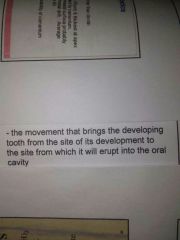
|
Pre-eruptive tooth movement |
|
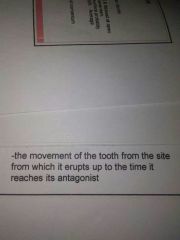
|
Eruptive tooth movement |
|
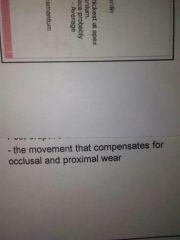
|
Post eruptive movement |
|
|
Process of tooth eruption |
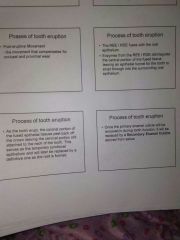
|
|
|
Once the primary enamel cuticle removed in during tooth function |
Secondary enamel cuticle |
|
|
Steps of tooth eruption |
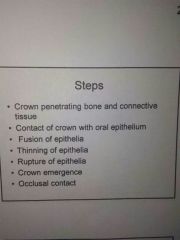
|
|
|
When deciduous teeth start to resorb |
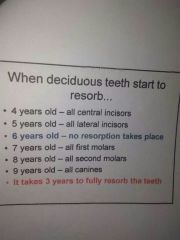
|
|
|
Factors relevant to eruption in relation to occlusion |
Normal period of eruption Normal sequence of eruption |
|
|
Actual time the teeth emerge into the oral cavity |
Normal period of eruption |
|
|
Usual order the teeth emerge into the oral cavity |
Normal sequence of eruption |
|
|
Eruption cyst A.K.A |
Eruptiin hematoma |
|
|
Devolops as a result of separation of the dental follicle from the crown of an erupting tooth that is within the soft tissues that overlines the alveolar bone |
Eruption hematoma |
|
|
Due to collagen deposition of the gingival connwctive tissue that results to a thicker, less penetrable pericoronal roof |
Eruption cyst |
|
|
Nolla's stage of tooth development |
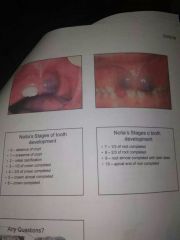
|

